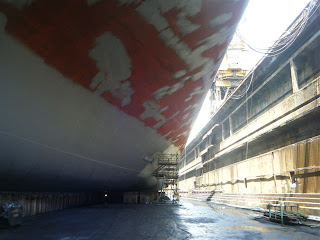This ship was dry docking in one of the shipyard locally.
The vessel has not replaced the transducers for the pass 10years. Consider the transducer very reliable. They come with 50Khz forward transducer and 200Khz aft transducer. Normally 200Khz transducer is used to detect shallow water depth as compare to 50Khz transducer. Basically, the LAZ5000 display was faulty due to unable to switch on. Replaced with LAZ5100 Display unit. The crew also complaint the slave display DAZ25 not showing correct depth when the Master display was working well with good depth before.
I have used my laptop to simulate a $DBT or $DPT at old DAZ25 found unable to update. So replaced with new DAZ25 and found working well with simulated nmea from laptop.
The first time went down to inner tank to locate the forward 50Khz transducer was a good experience. Caution need to be observe, ventilation must be provided with blower working in good condition. Working in confine space would require a gas detector been carried around the waist in case of oxygen level fall below 19percent or above 21percent, it will beep to warn of danger in confine space. Excess of CO2(Carbon Dioxide) can also be dangerous in confine space. So minimum of 2 person entering tank was necessary to prevent accident and seek help in case of accident do happen.
It was fully dark with a funny smell. Torch light should be strong and bright to find the right place. We enter into the inner tank from main deck with at least 4 levels down the vertical ladder before we reaching the bottom. The location was very small and only allow one person to reach the transducer. Finally we found 3 x transducers and the most left was identified as 50Khz echo sounder transducer and the smallest among compare to speed log transducer to the right.
I have instruct yard workers to remove the transducer from outside the bottom since ship was at dry dock. Cut the wire from inside around 1meter from transducer so that remove from outside would be easy. After removing the 3 bolts from outside transducer, we manage to slowly twist the transducer from side to side to rotate the transducer and finally made its way out. Replaced with new transducer is also tricky as the old transducer cable is useful to guide the new transducer cable to run through the trunking and all the way up to the junction box in a deck below main deck.
Finally the new transducer was fixed and connected. Display showed good reading after ship undock at the shipyard. Please see some of the pictures taken.







